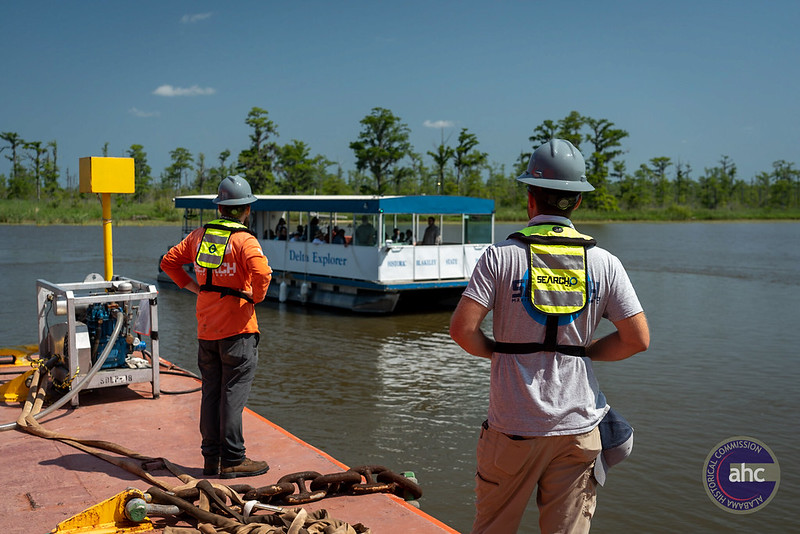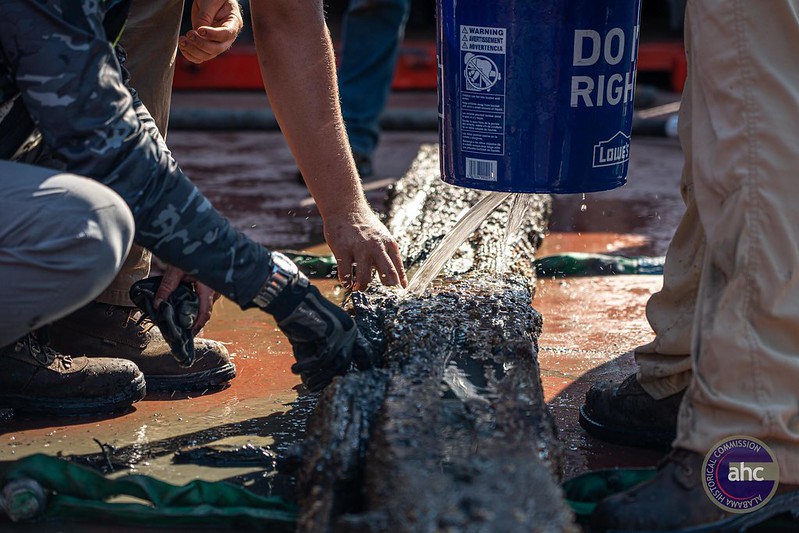

In its 2021 budget, the State of Alabama appropriated $1 Million to the Alabama Historical Commission (AHC) to begin Phase 3 of preservation efforts for the Clotilda, the last ship to bring enslaved people from Africa to America.
The Clotilda arrived in America after Congress had already banned the transatlantic slave trade—though the practice remained lucrative, and still occurred. It carried a cargo of 110 enslaved Tapka people from present-day Nigeria from the port of Whydah to Mobile Bay in 1859 or 1860.
Fearing capture, the Clotilda’s captain burned and sank the ship after arriving in Alabama. Its location remained unknown until 2018, when Mobile Register reporter Ben Raines led a team of researchers on an expedition near the 12 Mile Island area of the Mobile River.
Researchers kept the location secret for a year before the Alabama Historical Commission announced its discovery on May 22, 2019. Since then, the AHC has led the preservation and study effort on this historical find.
In 2021-2022, this multifaceted project has included targeted artifact excavation with industrial dive efforts supporting environmental and structural assessment of the site and an engineering study of the riverbed to learn about its stability. The environmental study examined the composition of the sediment around the wreck, monitored water movement, and performed a biological review of the species that have colonized the wreck area. A structural assessment appraised the level of deterioration and condition of the wood. This 10-day exploration began May 2 and ended May 11, 2022.
After transporting the barge and equipment to the project site and securing the work platform, (AHC) held a consultation meeting with the Africatown community and a press conference in the Robert L Hope Community Center. The RESOLVE dive team removed 10 trees, one stump, and a displaced buoy from the archaeological site to provide access to the archaeological divers and to provide unobstructed images in the remote sensing.
After confirming that the archaeological site was clear of obstructions, RESOLVE divers systematically removed 94 disarticulated timbers for archaeological assessment. That work focused on cataloguing every recovered timber, measuring, and photographing them, and in some cases with diagnostic ones, scanning them three-dimensionally. As this work progressed, professional maritime archaeologists from SEARCH conducted the initial archaeological analysis and preliminary identifications.
The RESOLVE dive team worked their way methodically around the wreck and finally through the center of the vessel to ensure that all the loose pieces were recovered and recorded. After the divers exited the water, Survtech ran multi beam sonar and aerial LiDAR to provide the first clear image of the wreck without all the trees, snags, and disarticulated timbers that previously obscured the view. SEARCH maritime archaeologists continued to collect side scan sonar imagery each morning so any changes to the site could be observed daily.
Conservators from Terra Mare joined the team and began a preliminary assessment of the condition of the disarticulated timbers and artifacts recovered. They also stress-tested a disarticulated piece of a hull plank to collect information about hull strength. Select artifacts were X-rayed by Applied Technical Services. SEARCH scanned the artifacts and disarticulated elements using Pix4D software to create photogrammetric images that may be viewed from multiple angles before RESOLVE divers placed them back inside the wreck.
Much of the work in this phase of investigation focused on environmental science. Dauphin Island Sea Lab is investigating what grows on and in the wreck, from bacteria to more visible marine organisms, and the role that those organisms play in the condition of the wreck. While some of those organisms are very visible, like the barnacles that colonized the timbers above the sediment and the small crabs and worms that crawl from waterlogged timbers, less visible organisms are also being studied, such as bacteria inhabiting the mud and the wood. Sealed in anaerobic mud, timbers are often protected from being eaten by riverine and marine organisms. The best conservation practice for the timbers that are not selected for further study is to place them back inside the wreck itself.
Maritime archaeological divers from SEARCH and Diving With a Purpose (DWP) dived the wreck and were finally able to inspect it without obstruction. RESOLVE divers established a centerline in the wreck, laid a 2.5-foot grid, and began systematic probing to confirm the portions of the wreck buried under the mud remain intact and to ascertain the depth of the mud inside the vessel and collected hand cores to observe the nature of the sediment in and around the vessel. The centerline and grid also help the archaeologists carefully control and record the location where samples are collected and where artifacts are recovered.
Once the recorded and tagged timbers were carefully placed back inside the wreck, the team prepared the tank on the barge for screening sediment. The amount of sediment removed during the current investigation is limited by the Army Corps[MS1] of Engineers (ACOE) permit. During the late morning, on Tuesday, May 10, RESOLVE divers began excavating by hand fanning silt and mud into a 3-inch dredge with a quarter inch screen on either end to remove the sediment in a very small section of the hold of the wreck. The purpose of the excavation is only to take a small sample for scientific analysis from the base of the sediment. These samples will inform the preservation state of the vessel and help AHC understand both the flora and fauna inhabiting the wreck and the preservation state of the buried portion of the vessel. The sediment was also hand screened by SEARCH maritime archaeologists as it was pumped into a holding tank onboard the barge. Screening sediment is standard archaeological methodology aimed at recovery of any small artifacts but none of significance were recovered during this investigation. As RESOLVE divers neared the base of the excavation, scientists from Western Carolina University and Stantec arrived onboard and prepared sterilized receptacles to receive scientific samples, secured the samples for travel, and took custody of the specimens for transport to the respective scientific labs in which the samples will be analyzed. Following the collection of the last samples for scientific analysis, burlap bags were filled with screened sediment collected in the holding tank. RESOLVE divers carefully placed the sandbags back in the vessel as a protection measure for the vessel itself and the timbers placed back inside. On Friday, May 13, the barge will be removed from the site.
In addition to the collection of scientific samples, the scope of the project allowed for the retention and conservation of diagnostic and display quality artifacts. Most of the disarticulated elements that were recovered were timbers and iron fasteners, but five artifacts were retained for additional analysis and possible conservation. AHC Historic Artisans worked with Terra Mare Conservators to build a smaller tank to hold and protect the largest selected artifact, which is a large timber with an iron pulley and fragments of rope in the pulley. There is a tentative identification, but additional analysis is needed to confidently identify its role on the schooner. The other items selected were a lead hawse pipe which a thick rope cable passed through to raise and lower the anchor, a small section of hull planking held together by iron drift pins, and a section of planking that retains marks from a circular steam saw. These artifacts will be temporarily stored at the History Museum until they have been analyzed for conservation. After analysis and conservation, these artifacts will help illustrate the story of the enslaved people on Clotilda.
During the entire 10 days on the project, conditions both on the river and underwater remained very favorable. The divers report that the visibility underwater was the best that has yet been observed on Clotilda since archaeological study of the wreck began in 2018 (ranging from 3” to about a foot). The current was low, and with the removal of the trees that once covered parts of the wreck, the dive team had an unobstructed view of the wreck. As with all responsible scientific investigation, this was a slow methodical process from which a picture of the wreck is slowly emerging. That picture will become even more clear as the data from the scientific analysis is analyzed and incorporated into the existing body of knowledge. What can be said with confidence in this preliminary stage is that the wood below the mudline is much better preserved than the sections of the shipwreck that extend into the water column. Probing in the stern section indicated that the ship is in two or more pieces with a section of the stern broken away and possibly preserved beneath the mud. Divers were able to get a first glimpse inside the hold where captives were held and observed vertical posts and a bulkhead that does not appear to part of the ship’s original architecture. It is too soon to speculate regarding the function of these features. More will be learned about them as the analysis stage of the project progresses.
“As the guardian of the Clotilda, the Alabama Historical Commission takes the stewardship of this priceless artifact extremely serious”, said Lisa D. Jones, State Historic Preservation Officer and Executive Director of AHC. “The preservation of The Clotilda is important to Africatown and the nation.” Jones continued, “Careful consideration for the protection, preservation, and interpretation of the Clotilda has been methodical, strategic and deliberate.”.
The samples taken for specialized analysis will be sent to their respective scientific labs. The four artifacts selected for additional study will be analyzed and conserved. The team will continue to collect data from the flow monitor for the next year and the team will continue to process the copious amount of data collected during the past two weeks. This information will be collated into a draft report. Once a draft report is written, it will be peer reviewed and submitted to the ACOE who will conduct appropriate consultation. Each of these steps takes time, but once all the data is collected, AHC will have a management plan for the wreck which we can bring to the stakeholders. This management plan will provide the information needed to make an informed, responsible decision regarding the best possible path towards protection, preservation, and interpretation of the Clotilda wreck site.